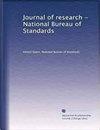Enhanced Multidimensional Luminescence Measurements Through Cyclodextrin Complexation
Journal of research of the National Bureau of Standards
Pub Date : 1988-05-01
DOI:10.6028/jres.093.109
引用次数: 1
Abstract
Cyclodextrins (CDxs) are cyclic oligosaccharides made up of 6, 7, or 8 glucopyranose units for a, /3, and y-CDx, respectively. These molecules are torus-shaped, with an interior cavity size ranging from 5 A for the smaller a-CDx to 10 A for the larger y-CDx. While the CDx is water soluble, the cavity is characterized as hydrophobic. Consequently, an appropriately sized hydrophobic molecule can form an inclusion complex with the CDx. Often, the molecules involved in these complexes exhibit different properties than their uncomplexed forms, such as precipitation of the CDx complex, or a change in spectroscopic parameters of the included molecule. Cyclodextrin chemistry therefore offers a means for gaining selectivity and sensitivity in a variety of analytical measurements. Many studies have demonstrated that the selectivity and accuracy of quantitative measurement of individual luminophors in a complex sample can be enhanced by simultaneous exploitation of multiple parameters. The combination of many multiple parameters could potentially provide specificity for the measurement. The most commonly used form of multidimensional luminescence measurement is the excitation-emission matrix (EEM), i.e., the measurement of the luminescence as a function of multiple excitation wavelengths (X,) and multiple emission wavelengths (XI,,). in this talk, we discuss the use of CDxs to enhance selective detection via EEM measurements. Particular emphasis will be placed on the enhanced measurement of luminophors complexed with CDxs in the presence of select alcohols and quenchers. In addition, the use of solvent extraction and data analysis to reduce the dimensionality of the acquired EEM will be discussed. Cyclodextrin complexation has been demonstrated to enhance the fluorescence of many types of included molecules. The lengthening of fluorescence lifetime [l], change in the fluorescence quantum yield [2], and shifts in the peak shape and position [3] have been observed as a consequence of complexation of fluorophors with CDxs. The addition of aliphatic alcohols to CDx systems has been shown to further enhance changes in these parameters [4]. These changes are often used to quantify the formation constants of a particular complex. Yet, in many instances, such changes are not of sufficient magnitude to quantify an analyte in a complex matrix. One method of further enhancing the selectivity of CDx complexation is through the use of added quenchers. The accessability of some quenchers to a fluorophor is reduced by complexation of the fluorophor with CDxs. The presence of aliphatic alcohols further reduces the quenching of a CDx included fluorophor. A model system employing naphthalene and B3-CDx will be discussed to demon-strate these principles. Appropriate SternVolmer type equations will be presented to explain the quenching phenomena observed in these studied. Quenching may be successfully exploited for the analysis of a mixture of fluorescent molecules in the presence of CDx, where complexes of differing formation constants and protection from quenching interactions are present. In many cases, quenchers interact similarly with various classes of fluorescent molecules. Even the coupling of selective fluorescence measurements employing EEMs with quenching may not be sufficient to analyze a particular component. Quenching and CDx complexation offers a means of selectively analyzing a single component in a complex matrix. Figure 1 demonstrates the selective enhancement of pyrene in a five component mixture. These measurements will be discussed using fluorescence EEMs to demonstrate their utility in mixture analysis. Cyclodextrin chemistry may also be successfully utilized in data reduction schemes for mixtures. Rank Annihilation schemes require the knowledge of one of the component spectra in order to elucidate other components present. Such a priori knowledge may not be available for some mixtures. The use of CDxs and quenchers can produce a singleor dual-component system from a more complex mixture, which can then be used as model component spectra. This type of data analysis scheme will be presented and discussed. Research in the area of CDx extraction presently employs low solvent volumes and requires precipitation of the complex from aqueous solution.通过环糊精络合增强多维发光测量
环糊精(CDxs)是一种环寡糖,分别由a、/3和y-CDx的6、7或8个葡萄糖醛酸单位组成。这些分子呈环状,其内部空腔大小从较小的A - cdx的5 A到较大的y-CDx的10 A不等。虽然CDx是水溶性的,但空腔的特征是疏水的。因此,适当大小的疏水分子可以与CDx形成包合物。通常,这些络合物中的分子表现出与其未络合形式不同的性质,例如CDx络合物的沉淀,或所含分子的光谱参数的变化。因此,环糊精化学为在各种分析测量中获得选择性和灵敏度提供了一种手段。许多研究表明,通过同时利用多个参数,可以提高复杂样品中单个发光物质定量测量的选择性和准确性。许多多个参数的组合可能为测量提供特异性。在这次演讲中,我们讨论了cdx的使用,通过EEM测量来增强选择性检测。特别强调将放在与cdx络合发光的增强测量在选择的醇和猝灭剂的存在。此外,还将讨论使用溶剂萃取和数据分析来降低所获得的EEM的维数。环糊精络合已被证明可以增强许多类型所含分子的荧光。荧光团与CDxs络合后,荧光寿命延长[1],荧光量子产率[2]发生变化,峰值形状和位置[3]发生变化。在CDx体系中加入脂肪族醇已被证明能进一步增强这些参数的变化。这些变化通常用于量化特定络合物的形成常数。然而,在许多情况下,这种变化的幅度不足以量化复杂矩阵中的分析物。进一步提高CDx络合选择性的一种方法是通过添加猝灭剂。一些猝灭剂对荧光团的可及性由于荧光团与cdx络合而降低。脂肪族醇的存在进一步降低了含CDx荧光体的猝灭。将讨论使用萘和B3-CDx的模型系统来演示这些原理。将提出适当的SternVolmer型方程来解释在这些研究中观察到的淬火现象。猝灭可以成功地用于分析CDx存在下的荧光分子混合物,其中存在不同形成常数的配合物和对猝灭相互作用的保护。在许多情况下,猝灭剂与各种荧光分子类似地相互作用。即使耦合选择性荧光测量采用EEMs与淬火可能不足以分析一个特定的成分。猝灭和CDx络合提供了一种有选择性地分析复杂基质中单一组分的方法。图1显示了芘在五组分混合物中的选择性增强。这些测量将使用荧光EEMs来讨论,以证明它们在混合物分析中的效用。环糊精化学也可以成功地用于混合物的数据还原方案。秩湮灭方案需要了解其中一个组分光谱,以便阐明存在的其他组分。对于某些混合物,这种先验知识可能不具备。使用cdx和淬灭剂可以从更复杂的混合物中产生单组分或双组分体系,然后可以将其用作模型组分谱。本文将介绍并讨论这种类型的数据分析方案。目前在CDx萃取领域的研究采用低溶剂体积,并且需要从水溶液中沉淀络合物。
本文章由计算机程序翻译,如有差异,请以英文原文为准。
求助全文
约1分钟内获得全文
求助全文

 求助内容:
求助内容: 应助结果提醒方式:
应助结果提醒方式:


